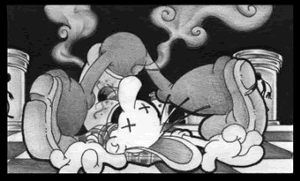It’s official: webcomics are better than print comics.
Sure, print comics have plenty going for them these days. But there’s one thing they don’t have: a superpowered cyborg Anne Frank with a positronic death ray in her mouth and the power to juggle an elephant, an automobile, a locomotive, and a chainsaw (it’s the inclusion of the chainsaw that pushes this material into the realm of genius) while whistling the tune to "Mexican Radio." For what feels like ages, guys like Scott McCloud have been raving that the Internet is where the art of comics will really re-ignite. Now, in fits and starts, we finally get to see that happen. In webcomics like Anne Frank Conquers the Moon Nazis, there’s a sense of joy, of silliness, of simply reveling in the freedom of cartooning, that is reminiscent of the best of the Golden Age print comics. So maybe it’s edgier than C.C. Beck, trying a little harder to shock and transgress. The glow is still there.
AFCTMN is drawn by Bill Mudron, the token male member of the Pants Press webcomics team. Mudron has the enviable ability to integrate his evidently extensive knowledge of classic cartooning into his art, creating comics in a vintage style that’s still distinctly his. Anne Frank has the look of an animated cartoon from the 1930s; characters follow the ball-and-hose design of cartoon characters like Betty Boop, Felix the Cat, and the early Mickey Mouse. The comic seethes with references to old cartoons, comics, and monster movies.
The story: in the 1950s, mad scientist Dr. Pretorius (why, yes, he is named after the maddest mad scientist in "Bride of Frankenstein"!) resurrects the dead, a project overseen by Nazi agent Walt Disney. Among the cloned is Anne Frank, whose skeleton is recovered from the ruins of a German concentration camp. In the present day, Pretorius has, after a long hiatus, resumed his work, thanks to generous military-research grants allotted by the Reagan administration. Max Fleischer (why, yes, he is named after the co-head of Fleischer Studios and director of classic Popeye, Betty Boop, and Superman cartoons!), a young genius janitor puttering around the Pretorius lab, catches sight of the Anne Frank clone, now an indestructible battle cyborg, and is – naturally – smitten. If the idea of reviving Anne Frank for sinister military purposes strikes you as a little… well… wrong, it’s probably best not to mention the friendly Jesus clone.
 This is a funny premise, and Mudron pumps it for humor. He has a solid sense of timing (the opening silent pages play very well) and a good ear for comic dialogue. Mudron’s art starts out strong and gets better, developing a full toolbox of classic cartoon stylistic tricks and a keen command of expression and gesture. Anne Frank is a black-and-white comic, drawn in a palette of soft grays that glow on the screen like an old movie. In recent pages, Mudron has abandoned word balloons in favor of typing the dialogue beneath the panels, like Kyle Baker. This gives his art more room to breathe, but does deprive readers of his appealingly quirky lettering. So far, Mudron has posted 22 pages (roughly comic-book size, although the dimensions vary) of what seems to be planned out as an epic story. Twenty-two pages is a fairly substantial helping of comics, but it still leaves you wanting more.
This is a funny premise, and Mudron pumps it for humor. He has a solid sense of timing (the opening silent pages play very well) and a good ear for comic dialogue. Mudron’s art starts out strong and gets better, developing a full toolbox of classic cartoon stylistic tricks and a keen command of expression and gesture. Anne Frank is a black-and-white comic, drawn in a palette of soft grays that glow on the screen like an old movie. In recent pages, Mudron has abandoned word balloons in favor of typing the dialogue beneath the panels, like Kyle Baker. This gives his art more room to breathe, but does deprive readers of his appealingly quirky lettering. So far, Mudron has posted 22 pages (roughly comic-book size, although the dimensions vary) of what seems to be planned out as an epic story. Twenty-two pages is a fairly substantial helping of comics, but it still leaves you wanting more.
That Anne Frank Conquers the Moon Nazis is a damn good comic – and it is – doesn’t excite as much as the realization that it’s an awfully fun comic, with an originality and playfulness that have been rare in comics of late. In the print comics industry, stuff like this has to struggle just to find an audience. Thank goodness for the Web.
Recent Comments